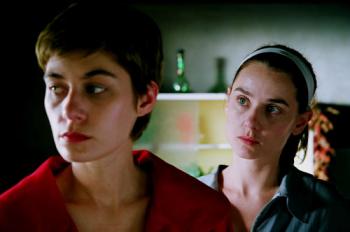CALGARY—In Titov Veles, Macedonia, a local factory produces toxic lead dust which blows into the city, condemning the inhabitants. Poverty is the norm—stench and ignorance are common.
Featured at the Calgary International Film Festival, I Am From Titov Veles depicts what it’s like to survive trapped, yet searching for a new life, amid stifling and noxious conditions.
Set in 2003, the film opens with the cameras following a young, weightless woman in worn shoes as she makes her way nimbly through the streets to a wall outside the local factory where a sparse group is protesting the factory’s pollution.
One woman shouts out that her son has a tumor the size of his stomach. “Don’t look away!” she yells desperately. Another protester had undergone surgery for breast cancer.
Even as the young woman is engaged by the protesters, she remains mute. She is Afrodita.
Since her mother left and her father died when she was 5 years old, Afrodita (Labina Mitevska) has been silent. Now 27 and virginal, she lives and shares a bed with her two older sisters—Sapho (Nikolina Kujaca), who yearns to get a visa and leave Titov Veles, and Slavica (Ana Kostovska), the eldest, a factory worker and methadone addict.
Though each sister struggles in this environment and strives to find a way out, the story is told from the perspective of Afrodita, much of it from within her enclosed thoughts and dreams.
A recurrent dream of Afrodita’s highlights the conflict in the story. Sickly-white human drones are physically integrated into factory mechanisms, their mouths and fingers connected to the machinery; their eyes closed, unseeing. They robotically produce offspring which are then carried, doomed, in an assembly line of people who march unresponsively into a lake to their deaths.
It is these ailing social and industrial mechanisms together that the sisters face in their own search for a better life. As the city has eroded, so have the people. Physicians are apathetic. The girls’ love-interests are vulgar. Every aspect of society that the girls encounter seems degenerate.
While some might find this scenario tragic, others might discover inspiration in the human spirit and vibrancy even amid such trying circumstances.
This isn’t a film about trying to pick up the pieces. It is a film about emerging from the dust and decay of a dysfunctional system and starting completely anew. There is a sense of hope and even certainty that once free of this old system, life will thrive.
Some relatively recent historical factors that have impacted the situation in Macedonia (prior to 2003 when this film is set) include membership in the Socialist Federal Republic of Yugoslavia, Titoist communism, Tito’s death, the declaration of independence, war between Albanian rebels and the Macedonian government, corresponding ethnic conflicts, and the Ohrid peace agreement.
Featured at the Calgary International Film Festival, I Am From Titov Veles depicts what it’s like to survive trapped, yet searching for a new life, amid stifling and noxious conditions.
Set in 2003, the film opens with the cameras following a young, weightless woman in worn shoes as she makes her way nimbly through the streets to a wall outside the local factory where a sparse group is protesting the factory’s pollution.
One woman shouts out that her son has a tumor the size of his stomach. “Don’t look away!” she yells desperately. Another protester had undergone surgery for breast cancer.
Even as the young woman is engaged by the protesters, she remains mute. She is Afrodita.
Since her mother left and her father died when she was 5 years old, Afrodita (Labina Mitevska) has been silent. Now 27 and virginal, she lives and shares a bed with her two older sisters—Sapho (Nikolina Kujaca), who yearns to get a visa and leave Titov Veles, and Slavica (Ana Kostovska), the eldest, a factory worker and methadone addict.
Though each sister struggles in this environment and strives to find a way out, the story is told from the perspective of Afrodita, much of it from within her enclosed thoughts and dreams.
A recurrent dream of Afrodita’s highlights the conflict in the story. Sickly-white human drones are physically integrated into factory mechanisms, their mouths and fingers connected to the machinery; their eyes closed, unseeing. They robotically produce offspring which are then carried, doomed, in an assembly line of people who march unresponsively into a lake to their deaths.
It is these ailing social and industrial mechanisms together that the sisters face in their own search for a better life. As the city has eroded, so have the people. Physicians are apathetic. The girls’ love-interests are vulgar. Every aspect of society that the girls encounter seems degenerate.
While some might find this scenario tragic, others might discover inspiration in the human spirit and vibrancy even amid such trying circumstances.
This isn’t a film about trying to pick up the pieces. It is a film about emerging from the dust and decay of a dysfunctional system and starting completely anew. There is a sense of hope and even certainty that once free of this old system, life will thrive.
Some relatively recent historical factors that have impacted the situation in Macedonia (prior to 2003 when this film is set) include membership in the Socialist Federal Republic of Yugoslavia, Titoist communism, Tito’s death, the declaration of independence, war between Albanian rebels and the Macedonian government, corresponding ethnic conflicts, and the Ohrid peace agreement.







Friends Read Free